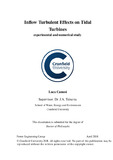JavaScript is disabled for your browser. Some features of this site may not work without it.
| dc.contributor.advisor | Teixeira, Joao Amaral | |
| dc.contributor.author | Camosi, Luca | |
| dc.date.accessioned | 2023-03-07T15:54:03Z | |
| dc.date.available | 2023-03-07T15:54:03Z | |
| dc.date.issued | 2018-04 | |
| dc.identifier.uri | https://dspace.lib.cranfield.ac.uk/handle/1826/19264 | |
| dc.description.abstract | Hydrokinetic tidal turbines are devices for which the relative importance of the incoming flow on fatigue life is higher when compared to wind generators. This is due to the difference in density between the two fluids and because of the more turbulent nature of marine channel flows [50] compared to winds. This work is part of an effort to produce a more accurate description of the impact of turbulence on open-rotor turbines in general. In order to reach the described scope the author conducted an experimental campaign and developed numerical tools within the OpenFOAM [5] CFD libraries. The experimental campaign conducted in IFREMER (Boulogne-sur-Mer France) provides data used for the numerical model validation. The developed models consists in two main parts: 1. an actuator line turbine model similar to that presented by Churchfield in [18] but more integrated with the OpenFOAM libraries 2. two novel generators of turbulence for Large Eddy Simulations (LES) inlet boundary conditions • one that combines the state of the art generator philosophy for CFD [60] with a more general statistical representation approach by Shinozuka and al. [57]. This method is designed to accurately match the first order statistics of a flow given the turbulence spectra in a position of interest. • a second approach has been developed in order to reproduce the typical flow structures particular of a specific site. It makes use of Proper Orthogonal Decomposition (POD) in order to describe the intrinsically non homogeneous nature of environmental turbulence. Such is the case in tidal channel flows. The combination of the developed libraries constitutes an enabling simulation toolbox for the study of tidal turbines dynamic response to turbulence. The author could test the qualitative behaviour of the second approach compared to the current state of the art showing promising results. Results from the first approach intended for the dynamic validation of the IFREMER turbine model are not shown in this thesis report being analysis not completed yet. The comparison of the torque and thrust signatures on the turbine from different inflow generators shows equivocally the importance of accurate modelling of turbulence when assessing the effects of dynamic load on hydrokinetic tidal turbines. Furthermore the POD methodology is used to analyse flow data from the Ramsey Sound site where the company sponsor of this work installed a full-size device. These show the high meaningfulness of the POD methodology in the description of turbulent flows. | en_UK |
| dc.language.iso | en | en_UK |
| dc.rights | © Cranfield University, 2015. All rights reserved. No part of this publication may be reproduced without the written permission of the copyright holder. | |
| dc.subject | Hydrokinetic tidal turbine | en_UK |
| dc.subject | open-rotor | en_UK |
| dc.subject | actuator line turbine | en_UK |
| dc.subject | novel generators of turbulence | en_UK |
| dc.subject | torque | en_UK |
| dc.subject | thrust | en_UK |
| dc.title | Inflow turbulent effects of tidal turbines, experimental and numerical study. | en_UK |
| dc.type | Thesis | en_UK |
| dc.date.embargo | 2022-05-03 | |
| dc.description.coursename | PhD in Energy and Power | en_UK |
